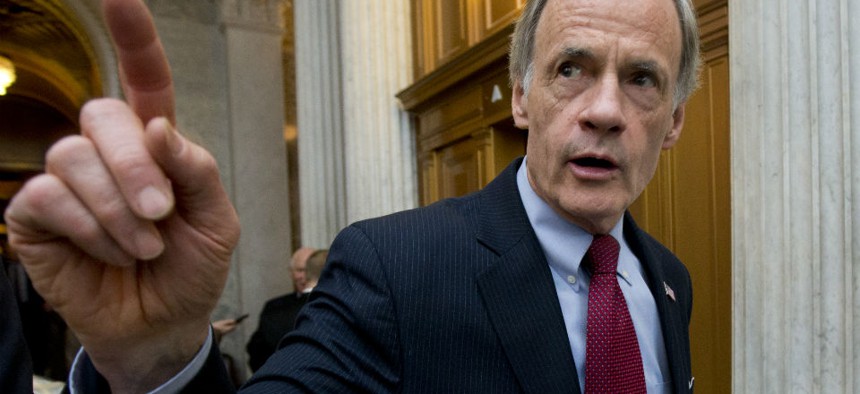
Sen. Thomas Carper, D-Del. Manuel Balce Ceneta/AP
Senators Want a Proper Count of Intelligence Contractors
Agencies need to know 'who is working for them and why,' oversight chairman says.
The 17 agencies in the intelligence community must get a better handle on the extent of their reliance on contractors, witnesses told a Senate panel on Wednesday. Overuse of outsourcing presents risks to both national security and managerial efficiency, senators and an auditor warned.
“Contractors can provide flexibility and unique expertise, but there are risks” if internal controls, formal planning and documentation are inadequate, Timothy DiNapoli, director of acquisition and sourcing management at the Government Accountability Office, told the Senate Homeland Security and Governmental Affairs Committee. “Changes to the definition of core contract personnel limit the comparability of the information over time,” he said, noting that the civilian intelligence community agencies used various methods to calculate the number of contract personnel and did not maintain documentation to validate the number of personnel reported for 37 percent of records reviewed. GAO also found that the civilian intelligence community agencies either under- or over-reported contract obligations by more than 10 percent for one-fifth of the records.
Panel Chairman Sen. Tom Carper, D-Del., said, “The people we entrust with leadership roles at these agencies need to be able to show the American people, and Congress, that they know who is working for them and why.” Overreliance on contractors behind the intelligence agencies’ secrecy walls presents three hazards, Carper said: hollowing out the in-house workforce and making it weaker, requiring extra layers of management and paying more for work that could have been performed by federal employees.
Inventories of contractors that have been required since 2006 “are a useful tool, and we are looking for ways to improve them,” said Stephanie O'Sullivan, principal deputy director and chief operating officer at the Office of the Director of National Intelligence. “But they’re not designed to be a 100 percent precise, auditable record, but rather a tool for strategic workforce management.” The director of national intelligence has been working to coordinate the inventories “across the community,” O’Sullivan said. “But we don’t control their records or manage their workforces.”
The intelligence community’s “17 elements, in six departments with two independent agencies, are subject to differing authorities, policies and oversight that can shift with the pace of headlines,” she added. “The right number [of contractors] for the intelligence community has to be fluid as gaps emerge and we respond to need,” O’Sullivan said, recalling how, following a government downsizing in the 1990s, the community worked after the 9/11 terrorist attacks to “surge” to fill gaps in anti-terrorism specialties, language skills and cyber skills with contractors who have “missions of limited duration.” Such workforce planning “is a 30-year decision we make, and has consequences that last,” she said.
The agencies also differ in their judgments on how to assemble data on contractors, she added.
GAO faulted the intelligence agencies for failing to follow up on instructions from a 2011 Office of Federal Procurement Policy memo clarifying “inherently governmental” functions, which required all agencies to prepare strategic workforce plans. Only the Homeland Security and State departments completed them, DiNapoli said.
Ranking member Sen. Tom Coburn, R-Okla., said, “This is a pretty damning report in terms of quality of management.” He asked O’Sullivan why agencies weren’t better documenting their contractor counts and why 80 of 103 records GAO sampled “did not find any unique expertise” in the outsiders hired. “You can’t make great decisions if don’t have accurate data,” Coburn said.
The intelligence community uses the inventories “to reexamine whether we really need the contractors, while still getting the mission done on time, so it’s very valuable,” she said. “Our reality is that all tracking indicators show we have gotten our contractor costs down.” The community’s planning allowed it anticipate the recent budget cuts two or three years in advance and “manage the transition, O’Sullivan said. She agreed with Coburn, however, that “we get better use of the taxpayers’ money with government employees rather than contractors.”
Sen. Claire McCaskill, D-Mo., spoke of a “crisis of confidence in the intelligence community” that calls for a “gut check,” alluding to the ongoing dispute between the CIA and the Senate Select Intelligence Committee over electronic files dealing with torture. Expressing frustration at the degree to which intelligence budgets remain classified, McCaskill said, “I don’t think it helps our enemies if they know the ratio of contractors to employees … Why does Booz Allen Hamilton have their contract information on their website?” O’Sullivan promised to provide more information on budget policy. McCaskill also said she wants “the administration to weigh in on better whistleblower protections for employees of contractors, who are working shoulder to shoulder with federal employees, and should have the same protections.”
Sen. Kelly Ayotte, R-N.H., expressed concern about intelligence agency security, noting that both National Security Agency leaker Edward Snowden and Washington Navy Yard shooter Aaron Alexis were contractors.
“There’s no corner on the market for who causes threats, it’s government employees equally,” O’Sullivan replied. “We’re now enhancing the process for all, using the same vetting process, regulations and monitoring,” including the more recent addition of continuous evaluation of longtime holders of security clearances.
Sen. Jon Tester, D-Mont., voiced concern about a “revolving door” of intelligence community employees, citing recruitment problems and the lure of the private sector. “We have a relatively low, 4 percent to 5 percent attrition rate,” O’Sullivan said. “One of the hardest skills to keep is contracting officers and cyber specialists,” she added. But, having noted that the community scores high in employee satisfaction on the Office of Personnel Management’s Employee Viewpoint Survey, she said, “People join this workforce to do public service. They get the mission and complete the work they do day to day to make a difference.”







